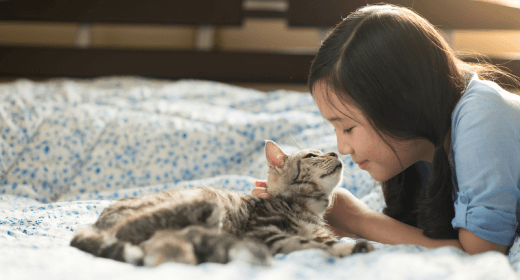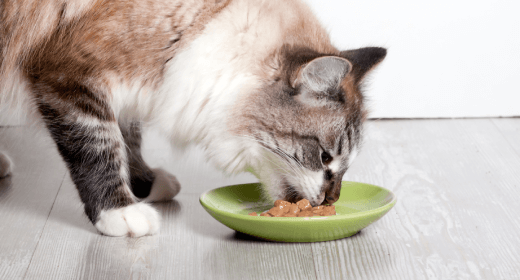

The average cat’s lifespan is around 15 years. While a cat’s lifespan indoors can range from 12 to 18 years, some pet cats even live for up to 20 years. Outdoor cats lead significantly riskier lives as they are more prone to accidents and being attacked by other outdoor animals. Moreover, they often cannot receive medical attention in cases of ailments or injuries. This leads to them have a shorter life expectancy in comparison to their indoor counterparts.
As a pet parent, you would want your fur baby to live a long and healthy life. It’s common sense that feeding your cat a high-quality diet has its benefits. But when it comes to maximizing your cat’s lifespan, diet is only part of the equation. Read up on everything you need to do to ensure your cat lives happily for a long time to come.
A cat’s age span is divided into six stages. To understand how you can maximise your cat’s life expectancy, it is necessary to understand these life stages.
From birth till 6 months, the cats are in their earliest years and are called ‘kittens’. They undergo quick development during this time and require a lot of nutrients.
From 6 months to 2 years of age, cats are considered ‘juniors’. During this time, they reach sexual maturity and develop a personality. When your cat is about a year old, they can be switched from kitten food to adult cat food.
Between the age of 3 to 6 years, cats are considered to have reached their ‘prime’ age. They will be in their best physical condition during this time. However, do make sure that you still take your cat to the vet for regular check-ups.
Cats are considered to be in their ‘mature’ life stage between 7 to 10 years of age. During this time, they might become less active. This might even cause them to put on some extra weight, so you may have to make changes to their diet. You may also have to add some extra vitamins to meals to improve immunity. This will be an important step in maximizing cat life expectancy.
Between 11 to 14 years of age, cats are considered seniors and are at a higher risk of catching an illness. Ensure that you make regular visits to the vet and consult them frequently to ensure that your fur baby is not missing out on nutrition.
At the age of 15 years or higher, cats are at the ‘geriatric’ life stage. During this time, they may remain mostly inactive and need more attention.
Here is a brief guide to explain what the average age of cats is in human years:
When a cat turns 2 years of age, it is considered equivalent to a human turning 24 years old.
After a cat turns 2, each following year in their life amounts to 4 human years. So, when a cat is 3 years old, it amounts to 28 human years; when 4 years old, it amounts to 32 human years, and so on.
Knowing what affects your pet’s lifespan can help you take the right steps to prolong longevity.
Let’s start with something you do every day: feed your cat. There are several healthy options to choose from, so we’ll help you zero in on the formula that’s best for your cat. It’s important to note that cats are natural carnivores. Therefore, a formula with meat as the primary ingredient is a great place to start. Meat as a protein source has certain nutrients, such as taurine, that non-meat protein sources simply do not. Also, along with a proper diet, ensure your cat stays hydrated.
Regular visits to the veterinarian can help nip health issues in the bud. For instance, a vet will be able to tell if your cat is gaining too much weight and can recommend a diet and fitness program to get your kitty back to a healthy size.
You may even want to bring a fresh faecal sample along to your next appointment. Your vet can use this sample to search for ringworms. This tip can save you extra trips to the vet’s office in case your cat does not cooperate, so to speak, during their appointment.
Also, vets provide your cat with the vaccinations they need to fight off diseases such as feline rabies. Some vaccinations are required annually, while others should be administered every three years. Your vet’s office can help you keep track of it all, so remember to schedule that appointment!
Your cat relies on you for more than just healthy food and fresh water. They need stimulation. Sure, cats love their independence, but let’s be honest, they love getting attention. By playing with your cat for even 10 to 15 minutes a day, you are doing wonders for their lifespan. Some great games to play don’t even require fancy toys. Get a piece of string and tie it around a clean sock, then yank the string whenever your cat comes in close to investigate. Voila! Instant fun!
Cats don’t go on runs as dogs do, so keeping your cat active with games and toys is the best way to help keep them fit. About 30 minutes of exercise or playing in a day is enough to have a significantly positive impact on maximizing your cat’s lifespan.
If your pet’s teeth are left unclean, they can develop plaque and tartar which can cause severe problems like pain, tooth loss, or kidney ailments. So, ensure that you take your cat for regular dental check-ups.
Follow these tips and your cat will be on her way to a long and happy life with you. You’re a great owner for taking the time to read this article. It shows how much you really care about her. Now step away from the computer and show your cat some attention!


AMS Cat Food offers chicken as number 1 source to build up cat’s nutrition and immunity
Author: Dr. Cissy Ramos
To help owners better maintain the health and development of their cats, IAMS has developed a line that is uniquely tailored for cats’ needs and has chicken as its number one ingredient. IAMS Cat food includes Taurine as an additional supplement for natural variability and production process.
A study conducted by WALTHAM Centre for Pet Nutrition reports that cats prefer food that is similar to their natural prey such as mice or birds. Likewise, the evolutionary ancestors of cats did not consume fish.
Cats are considered as strict carnivores and they’re still highly related to their ancestors. Their teeth and skull conformation are actually designed to hunt and kill prey efficiently.
In fact, cats are obligate carnivores and they eat meat out of biological necessity. The same study also found that 52% of a cat's calorie intake is from protein, which can be synthesized best through animal-based protein. Therefore, cats require quality protein sources to be included in their diet for sustenance.
Animal-based protein can help cats maintain healthy muscle structures and provide them with natural forms of amino acids. Adding certain sources of protein, especially animal sources, cats can easily process it, break it down, and use it up in their body. Animal sources proteins like chicken can greatly contribute to the quality of protein in their diet and they do get appropriate amount of essential amino acids from it.
In total, cats can internally produce 11 essential amino acids. However, the remaining 11 categories of amino acids can only be provided through a nutritious diet to meet their needs. When you have good quality protein, the cat can receive a good amount of amino acids that are important for its health. The protein from chicken contains multiple levels of essential amino acids, such as Lysine, Phenylalanine, Arginine, and Taurine.
Cats can get a great amount of Lysine from chicken. If there is deficiency in Lysine, the side effects would be low appetite and depression for cats.
Another crucial essential amino acid for cats would be Phenylalanine. If cats have a low amount of Phenylalanine, there are instances that black cats can turn into brown cats because Phenylalanine is in charge of production of melanin for cats. It’s not just for the coloring but that’s the most obvious sign that there’s a deficiency.
Cats need more Taurine compared to other mammals as it supports excellent eyesight. We know for a fact that cats are hunters, and they need good eyesight for that.
Taurine, an especially essential amino acid for cats, is a critical component that supports heart muscle function, vision, digestion, and fetal development. The recommendation of Taurine for cats is around 35 to 55 milligrams of Taurine per kilogram per day. In fact, low levels of Taurine in kittens can lead to blindness, heart failure, congenital defects, and poor immune response.
It is necessary for cat owners to choose a diet that is made by a trusted brand like IAMS: palatable, complete, balanced, contains high quality protein, and enriched with amino acids. This will play a key role for the proper development and normal functioning of cats and enhance their wellness.
The importance of considering the life stage of cats when feeding them is also crucial for cat’s nutrition. With this, IAMS food products offer different varieties of cat foods–dry or wet and for each life stage. For each life stage, there are specific recommendations for the amount to feed and the levels of nutrients that they need.
IAMS cat food is formulated with colostrum and contains DHA found in mother’s milk for kittens cognition, as well as a signature blend of wholesome fiber and FOS natural prebiotic for healthy digestion. IAMS is scientifically proven to help increase the level of Vitamin E in your cat for healthy natural defense.
In addition, IAMS food products can help address specific health concerns in cats. Cats habitually groom themselves and have a tendency to ingest their fur. Of course, the risk of hairball formation is much higher for long-haired cats. Additionally, indoor cats tend to be obese due to overfeeding, inactivity, or sometimes it is simply caused by genetics.
IAMS offers hairball formula which cater to cats in order to reduce the passage of hair in the cat’s digestive tract. . IAMS also offers cat food that is specifically designed for weight management for cats who are obese.
Having protein in your cat’s diet is vital for its overall health and long-term wellbeing. For more information about IAMS Cat visit https://iams.asia/my/. IAMS Cats is available at all leading supermarkets and grocery stores nationwide.